- Bidadari Island
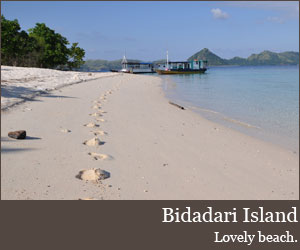 Bididari
Island is another popular daytrip destination for those heading out of
Labuan Bajo or Wae Cicu and the white sand beach certainly doesn't
disappoint.
If you're visiting on a daytrip, expect to be dropped on a sandy stretch
on the northeast coast of the island. The reef is right offshore and
has a good drop off. This spot was particularly notable for the volume
of fish and we also saw a seasnake here which was a great surprise. The
beach is very attractive and is fairly well looked
Bididari
Island is another popular daytrip destination for those heading out of
Labuan Bajo or Wae Cicu and the white sand beach certainly doesn't
disappoint.
If you're visiting on a daytrip, expect to be dropped on a sandy stretch
on the northeast coast of the island. The reef is right offshore and
has a good drop off. This spot was particularly notable for the volume
of fish and we also saw a seasnake here which was a great surprise. The
beach is very attractive and is fairly well looked - Gili Air
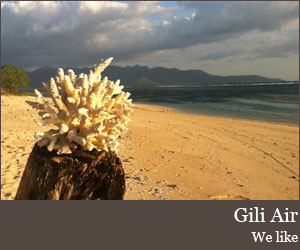 Gili
Air is the closest to Lombok of the three Gili islands. In size, it
lies between Meno and Trawangan, and has the largest normal community.
Unlike Gili Meno and Gili Trawangan, Gili Air actually does have its own
water source and you'll notice immediately how much greener and
overgrown it is compared to the other two far more arid islands. Much of
the interior is given over to coconut cultivation, though tourists are
proving themselves a more lucrative crop and slowly the palm
Gili
Air is the closest to Lombok of the three Gili islands. In size, it
lies between Meno and Trawangan, and has the largest normal community.
Unlike Gili Meno and Gili Trawangan, Gili Air actually does have its own
water source and you'll notice immediately how much greener and
overgrown it is compared to the other two far more arid islands. Much of
the interior is given over to coconut cultivation, though tourists are
proving themselves a more lucrative crop and slowly the palm - Gili Gede
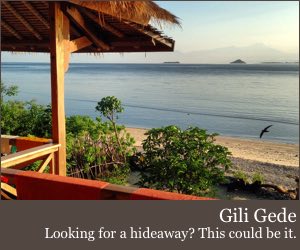 Gili
Gede is arguably the best known of the Secret Gilis -- a sprinkling of
islands off the coast of southwest Lombok far lesser known than the
Gilis of the northwest. Gili Gede lies among a group also comprising
Gili Layan, Gili Ringgit and Gili Asahan -- about halfway back to Lembar
is a second cluster including Gili Nanggu and Gili Sudak. Of all these,
Gili Gede has the broadest selection of accommodation.
At time of writing (mid-December 2014) there was a single midrange
resort on Gili
Gili
Gede is arguably the best known of the Secret Gilis -- a sprinkling of
islands off the coast of southwest Lombok far lesser known than the
Gilis of the northwest. Gili Gede lies among a group also comprising
Gili Layan, Gili Ringgit and Gili Asahan -- about halfway back to Lembar
is a second cluster including Gili Nanggu and Gili Sudak. Of all these,
Gili Gede has the broadest selection of accommodation.
At time of writing (mid-December 2014) there was a single midrange
resort on Gili - Gili Meno
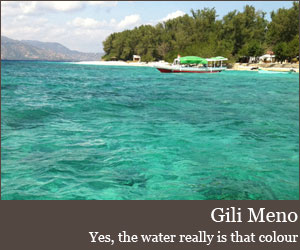 Situated
midway between Gili Trawangan and Gili Air, Gili Meno is the smallest
and least developed of the three Gili islands.
Peanut-shaped, with a brackish seawater lake towards its western coast,
this arid island is ringed by a good selection of places to stay and is
the most affordable of the three islands.
As with the others, Gili Meno is encircled by a rather pretty white sand
beach, and, as with Gili Air, there is some pretty good snorkelling to
be had.
While it is the least
Situated
midway between Gili Trawangan and Gili Air, Gili Meno is the smallest
and least developed of the three Gili islands.
Peanut-shaped, with a brackish seawater lake towards its western coast,
this arid island is ringed by a good selection of places to stay and is
the most affordable of the three islands.
As with the others, Gili Meno is encircled by a rather pretty white sand
beach, and, as with Gili Air, there is some pretty good snorkelling to
be had.
While it is the least - Gili Trawangan
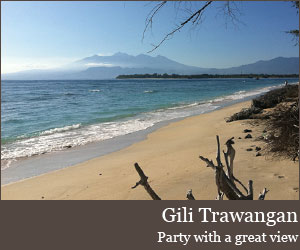 Gili
Trawangan, or Gili T to its friends, is the largest of three islands
scattered off Lombok's northwest coast. While all three of these Gilis
(Gili means island in the Sasak language of Lombok) are especially
photogenic, each has a character of its own and attracts a certain crowd
-- in the case of Gili T, it's the party set.
It is a very pretty island. You'll have near endless opportunity to take
photos to make the office back home suitably jealous. The beaches here
really are white sand
Gili
Trawangan, or Gili T to its friends, is the largest of three islands
scattered off Lombok's northwest coast. While all three of these Gilis
(Gili means island in the Sasak language of Lombok) are especially
photogenic, each has a character of its own and attracts a certain crowd
-- in the case of Gili T, it's the party set.
It is a very pretty island. You'll have near endless opportunity to take
photos to make the office back home suitably jealous. The beaches here
really are white sand - Kanawa Island
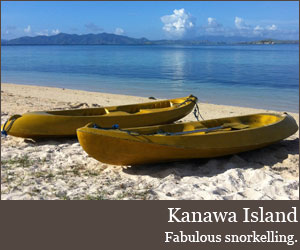 A
beautiful island about one and a half hours by boat more or less due
west of Labuan Bajo, Kanawa Island is a bit of a go-to location for
backpackers and flashpackers looking for some downtime.
The island is surrounded by a reef, some of which is in extremely good
condition with an impressive range of sealife, from soft coral through
to sting rays, sharks and turtles -- and it's easy swimming distance
from the beach. The beach itself is also very attractive, with ample
shade, and you're
A
beautiful island about one and a half hours by boat more or less due
west of Labuan Bajo, Kanawa Island is a bit of a go-to location for
backpackers and flashpackers looking for some downtime.
The island is surrounded by a reef, some of which is in extremely good
condition with an impressive range of sealife, from soft coral through
to sting rays, sharks and turtles -- and it's easy swimming distance
from the beach. The beach itself is also very attractive, with ample
shade, and you're - Karimunjawa Islands
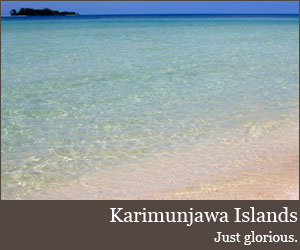 The
Karimunjawa Islands are an idyllic group of 27 tropical islands
surrounded by aquamarine water and coral reefs located approximately 120
kilometres north of the Central Java city of Semarang and 90 kilometres
north of Jepara.
Disappointingly for the local tourism industry, foreigners are
infrequent visitors to these stunning islands, meaning the
infrastructure sometimes feels a little rudimentary which can be good or
bad depending on your point of view.
The
Karimunjawa Islands are an idyllic group of 27 tropical islands
surrounded by aquamarine water and coral reefs located approximately 120
kilometres north of the Central Java city of Semarang and 90 kilometres
north of Jepara.
Disappointingly for the local tourism industry, foreigners are
infrequent visitors to these stunning islands, meaning the
infrastructure sometimes feels a little rudimentary which can be good or
bad depending on your point of view. - Nusa Ceningan
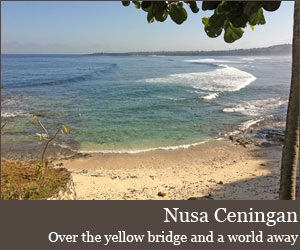 The
sliver of land that makes up Nusa Ceningan lies directly to the south
of Nusa Lembongan in the main channel between Lembongan and far larger
Nusa Penida. The northern channel (Ceningan Strait) runs almost dry at
low tide while the southern channel (Toyo Pakeh Strait) is a roaring
flow with swirling eddies and very fast currents.
The Ceningan Strait runs almost dry at low tide and is given over to
seaweed cultivation at the western end. It's also this channel that has
the yellow
The
sliver of land that makes up Nusa Ceningan lies directly to the south
of Nusa Lembongan in the main channel between Lembongan and far larger
Nusa Penida. The northern channel (Ceningan Strait) runs almost dry at
low tide while the southern channel (Toyo Pakeh Strait) is a roaring
flow with swirling eddies and very fast currents.
The Ceningan Strait runs almost dry at low tide and is given over to
seaweed cultivation at the western end. It's also this channel that has
the yellow - Nusa Lembongan
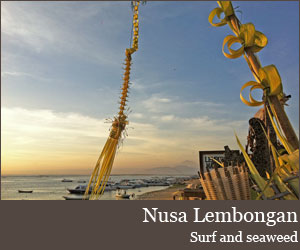 Nusa
Lembongan occupies a comfortable middle ground between well-trafficked
Bali and relatively untouched Nusa Penida. It's not as pretty as either
of the other two islands, but it has a banquet of good places to stay, a
friendly bunch of locals and makes for a comfortable time-out.
Lembongan is known for two things: seaweed and surf. Seaweed cultivation
and harvesting is what keeps the bulk of the local population busy. It
is farmed off many of the beaches (likewise on neighbouring Nusa)
Nusa
Lembongan occupies a comfortable middle ground between well-trafficked
Bali and relatively untouched Nusa Penida. It's not as pretty as either
of the other two islands, but it has a banquet of good places to stay, a
friendly bunch of locals and makes for a comfortable time-out.
Lembongan is known for two things: seaweed and surf. Seaweed cultivation
and harvesting is what keeps the bulk of the local population busy. It
is farmed off many of the beaches (likewise on neighbouring Nusa) - Nusa Penida
 Nusa
Penida dwarfs nearby Nusa Lembongan and Nusa Ceningan, yet is almost
devoid of tourists. For all intents and purposes there are only three
(yes, three) places even worth considering staying at, despite miles
upon miles upon miles of beautiful beaches, an attractive hinterland and
a generally unspoilt vibe about the place.
Before you pack your bags, a couple of disclaimers:
The vast majority of beaches, with the notable exception of Crystal Bay,
are given over to seaweed farming.
Nusa
Penida dwarfs nearby Nusa Lembongan and Nusa Ceningan, yet is almost
devoid of tourists. For all intents and purposes there are only three
(yes, three) places even worth considering staying at, despite miles
upon miles upon miles of beautiful beaches, an attractive hinterland and
a generally unspoilt vibe about the place.
Before you pack your bags, a couple of disclaimers:
The vast majority of beaches, with the notable exception of Crystal Bay,
are given over to seaweed farming. - Sabolo Besar Island
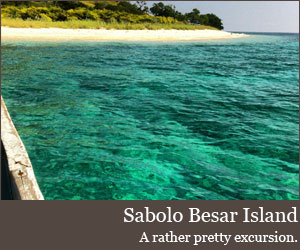 A
popular day trip from Labuan Bajo or Seraya Island, Sabolo Besar is the
larger of two islands more or less directly north of Komodo National
Park.
The island has a brilliantly white sand and broken coral pinnacle on its
east coast that juts out into the water and, when it isn't covered in
flotsam, offers picture-postcard white sand beaches and amazing
turquoise waters.
The best snorkelling is off the south side of the pinnacle -- walk as
far along the sand as you can then just swim out.
A
popular day trip from Labuan Bajo or Seraya Island, Sabolo Besar is the
larger of two islands more or less directly north of Komodo National
Park.
The island has a brilliantly white sand and broken coral pinnacle on its
east coast that juts out into the water and, when it isn't covered in
flotsam, offers picture-postcard white sand beaches and amazing
turquoise waters.
The best snorkelling is off the south side of the pinnacle -- walk as
far along the sand as you can then just swim out. - Seraya Island
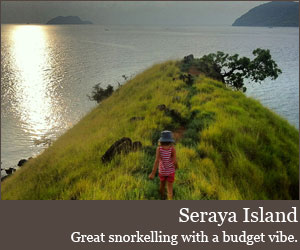 Set
north of Labuan Bajo, about an hour away by boat, Seraya Island has an
excellent offshore reef and drop-off and a good beach for lazing on.
The reef is in very good condition and the volume and variety of fish
(at least to snorkelling amateurs like us) appeared to be even more
varied than at Kanawa. Expect to see sharks off the north point and
turtles straight off the centre of the reef.
There is a channel, more or less right in front of the restaurant, that
you're encouraged to swim
Set
north of Labuan Bajo, about an hour away by boat, Seraya Island has an
excellent offshore reef and drop-off and a good beach for lazing on.
The reef is in very good condition and the volume and variety of fish
(at least to snorkelling amateurs like us) appeared to be even more
varied than at Kanawa. Expect to see sharks off the north point and
turtles straight off the centre of the reef.
There is a channel, more or less right in front of the restaurant, that
you're encouraged to swim - Togean Islands
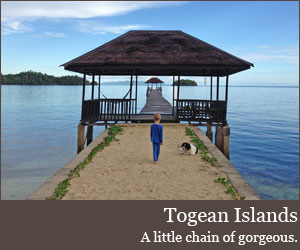 The
Togean -- or Togian -- Islands are an archipelago in the southeast
region of the Tomini Sea in northern Sulawesi. Famous for both their
difficulty to reach and diving, the archipelago is formed by seven
primary islands situated near the centre of a global hotspot of
biodiversity known as the coral triangle. Home to a great number of rare
marine and terrestrial species, most tourists who come here are divers
or snorkellers hoping to see some of the world's best marine life in
unspoiled
The
Togean -- or Togian -- Islands are an archipelago in the southeast
region of the Tomini Sea in northern Sulawesi. Famous for both their
difficulty to reach and diving, the archipelago is formed by seven
primary islands situated near the centre of a global hotspot of
biodiversity known as the coral triangle. Home to a great number of rare
marine and terrestrial species, most tourists who come here are divers
or snorkellers hoping to see some of the world's best marine life in
unspoiled
7/20/2015
Islands in Indonesia
Đăng ký:
Đăng Nhận xét (Atom)

Không có nhận xét nào:
Đăng nhận xét
Thanks. See us more at http://www.viptourasia.com